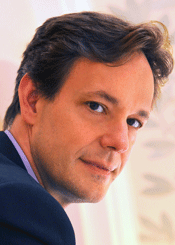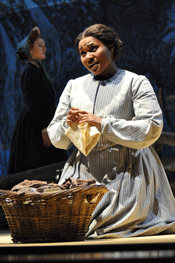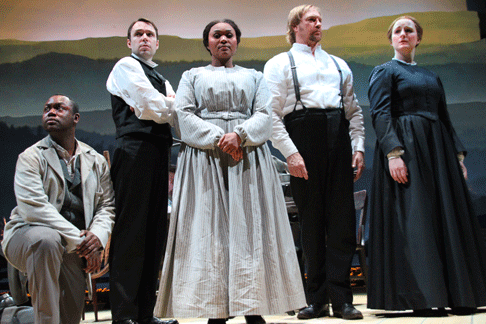19 Apr 2011
Americans define new territory for songs
They all wrote songs — lots of them: Ives, Bernstein, Rorem. In recital, however, the American product has never found a place on the perch claimed by Schubert and Schumann.

They all wrote songs — lots of them: Ives, Bernstein, Rorem. In recital, however, the American product has never found a place on the perch claimed by Schubert and Schumann.
(When did you, for example, last hear Elie Siegmeister’s Strange Funeral in Braddock, the 1936 documentation of a day when Marxism was not yet a curse in America?) Happily, things are changing — largely due to the commitment to song on the part of two Americans now moving toward middle age: Jake Heggie and Ricky Ian Gordon.
True, both men made their strongest mark in opera. Heggie’s Dead Man Walking, premiered in San Francisco in 2000, has become the most-performed opera of the 20th century, although in all probability it will soon by outranked by his Moby Dick, first staged by Dallas Opera a year ago. And Minnesota Opera offered Gordon’s touching treatment of Grapes of Wrath in 2007. Although both men are somewhat too easily pegged as “post-Broadway” and “post-Sondheim,” their achievement of the past month indicates it is time to take them with greater seriousness and see them as original and unique voices that elevate the status of American music. Their newest achievements in songs define new parameters for the genre.
*******
Heggie returned to Dallas’ Winspear Opera House on April 8, 2011,for the premiere of a new song cycle, A Question of Light. The six songs, again a colaboration with Gene Scheer, whose poems respond to works in the Dallas Art Museum, celebrate the philanthropy of Margaret McDermott, for whom the Winspear’s auditorium is named. “They are works either given to the Museum by Margaret or by friends in tribute to her,” explained Scheer, whose partnership with Heggie finds the two widely referred to as the “Strauss/Hofmannstal of the 21st century.”
 Jake Heggie [Photo © Ellen Appel]
Jake Heggie [Photo © Ellen Appel]
“We had turned earlier to works of art for inspiration,” Scheer added “And in Dallas we had gotten to know Margaret, an incredible philanthropist and a great friend.” Scheer and Heggie toured the Dallas Museum to study 40 works that fit the definition of the project. “There were six that immediately triggered my imagination,” Scheer said. “I found words right away for Magritte, but came up with nothing for Mondrian — and then one day it was there.”
The works are: The Light of Coincidences by Rene’ Magritte, a Mayan flint depicting a crocodile canoe from between 600 and 900A.D., Gustave Caillebotte’s Yellow Roses in a Vase, Piet Mondrian’s Place de la Concorde, El Hombre by Rufino Tamayo and Gerald Murphy’s Watch. “Jake had his heart set on the Tamayo,” Scheer said. “And I loved it as well.”
Although Scheer’s poems stand stably on their own (the audience would have gained from projection of the texts), they are enhanced by the changing moods of Heggie’s candidly romantic settings. Heggie sets the cycle in motion with bell-like Impressionist sounds for Magritte, grows dreamy in Caillebotte and gains Latin force in flavor in Tamayo. Heggie, long the master accompanist of his work, partnered baritone Nathan Gunn in the premiere. While Gunn sings Mozart’s Papageno at the cavernous Met, the 2,200 Winspear seemed a trifle large for his cultivated delivery.
On the second half of the program, a gala fundraiser for Dallas Opera, Gunn turned to music reaching from Home on the Range to a “hit” from Camelot. Here he was almost upstaged by his keyboard partner — and also his wife — Julie Jordan Gunn, a professor of music at the University of Illinois at Urbana-Champaign. “Moby Dick took me to a new level in my composition,” Heggie said. “And these songs are a direct extension of that musical language and world. “Each part of the cycle asks who we are and how we fit into the landscape — what a work of art says to us, and what we bring to it as we look at it as well.”
*******
It was hardly a coincidence that the Virginia Arts Festival scheduled the world premiere of Rappahannock County for April 12, 2011. For it was on April 12, 1861 that the attack on Fort Sumter in Charleston Harbor launched the Civil War. Rappahannock County, a music theater piece composed by Ricky Ian Gordon with texts by Mark Campbell not only recalls that event, it traces the fate of the divided nation through the five years of war that followed. To add to the significance of this cycle of 22 songs that follow the feelings of those affected by the war the Festival made the premiere the opening event of its 15th anniversary season.
 Aundi Marie Moore and Faith Sherman [Photo by David Beloff courtesy of Virgina Arts Festival]
Aundi Marie Moore and Faith Sherman [Photo by David Beloff courtesy of Virgina Arts Festival]
In commissioning it, Virginia Festival director Robert Cross asked only for a work on the Civil War. What exactly it would be was up to Gordon and Campbell. “I couldn’t see a big three-act opera on the war,” Gordon says. “The challenge was to make the subject manageable — to cut it down.” Gordon brought Campbell on board, and they both started reading.
“Virginia was so central to the war — and so divided!” Gordon says. “We decided to focus on just one county in the state: Rappahannock.” The two decided on music theater as their genre, and Gordon thought in terms of a cycle of songs to be performed by a small group of singers, each of whom plays a number of roles. Although the final score is divided into five acts — one for each year of the war — they are performed without interruption. The work lasts 85 minutes. “The poems offer no cohesive narrative, they must be performed without intermission,” the composer says. “That would break the mounting intensity of the cycle.”
Campbell’s texts draw on letters, diaries and other documents from a group of people, both black and white, who experienced the impact of war first hand. The goal of the creative team was a work in which individuals speak with intimacy. “But the personal is political,” Gordon says, “and the political is personal. “The piece has the sense of a lens closing in on a spectrum of individuals and their feelings around slavery and morality in a profound and poignant way. Mark’s libretto shows what everyone has to lose — or has lost.”
 Full cast of Rappahannock County [Photo by Rachel Greenberg courtesy of Virginia Arts Festival]
Full cast of Rappahannock County [Photo by Rachel Greenberg courtesy of Virginia Arts Festival]
The acclaim accorded Rappahannock County by the 2,200 people who packed Norfolk’s Harrison Opera House for the premiere made clear that Gordon and Campbell had achieved their goal. The work, described by Gordon as “a series of snapshots of life and loss during the war,” makes no attempt at narrative unity, but focuses rather on intensely emotional moments in the lives of 30 individuals portrayed in Norfolk by five extremely talented young singers. Indeed, soprano Aundi Marie Moore, mezzo Faith Sherman, tenor Matthew Tuell and baritones Kevin Moreno and Mark Walters were an unusually well balanced group of singers who clearly had taken the message of this stellar new work to heart. For the texts Campbell created a language magnificently suited to their contents. It reflects the period and the events described with no attempt at dialect-like coloring. Wisely, the texts were projected as supertitles during the performance.
The 17-pieces orchestra — Rob Fisher conducted Bruce Couglin’s orchestration of the score — played behind a scrim, on which were projected telling visuals designed by Wendall Harrington. They included actual photographs along with landscapes and documents that contributed much to the easy flow of the score. Gordon had wanted the songs to be performed without interruption; but, growing applause documented the increasing involvement of the audience during the premiere performance.
Costumes were by Jessica Jahn; lighting by Robert Wierzel. Kevin Newbury directed the production.
Rappahannock County is a co-commission of the 2011 Virginia Arts Festival, Virginia Opera, the University of Richmond and the University of Texas in Austin, The Norfolk production will be staged at both universities in September 2011.
*******
Next up for Jake Heggie and Gene Scheer is a commission from Houston Grand Opera for a set of songs marking the 10th anniversary of the 2001 terrorist attack on New York City. “Through music, the work will honor Houstonians affected by the attack,” said HGO general director Anthony Freud in announcing the commission. “Music, after all, has the ability to tell a story and enable people to reflect and connect with each other.”
Scheer is developing texts from — among other sources — interviews with Houston firefighters who went to New York to assist in rescue operations and from telephone messages left by a Houston-born woman on the flight that went down in Pennsylvania. Freud has asked Heggie for a “transportable” work, written for example, voice plus guitar, violins or flutes. “This will make it possible to perform it in many different venues from fire stations, city-hall foyers and hospitals,” Freud said. Plans are not yet definite. Yet, the HGO hopes to premiere the work in Houston’s Rothko Chapel. This is the eighth Heggie-Scheer collaboration.
Wes Blomster